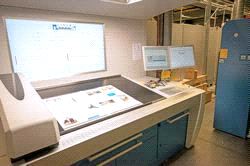Offset Printing
Drukkerij Paesen in Opglabbeek, Belgium

Thursday 22. May 2014 - KBA Rapida 106 with HR-UV replaces two presses
Drukkerij Paesen in Opglabbeek, Belgium, has invested in a KBA Rapida 106 sheetfed offset press with HR-UV drying. This was a big step as the high-performance press replaced both a four and five-colour medium-format press.
Managing director Guy Paesen: “Together with my two brothers, I have come to the conclusion that the Rapida 106 HR-UV is the best investment we could have made.”
Drukkerij Paesen is run by the brothers Mathieu, Marc and Guy Paesen. Following in the footsteps of their father, who opened a small village printing shop 68 years ago, they have expanded the company to include in-house design, prepress, printing and finishing services. In the mid-80s, the firm moved from the town centre to a large facility in the industrial park in Opglabbeek, where currently some thirty professionals and printers work in two shifts.
The business idea was to shut down a four and five-colour press and instead use the new four-colour Rapida with HR-UV drying to produce the same volume of printed material. The older five-colour press is still kept on hand as a backup.
At the Paesen brothers went looking for a new four-colour press to replace a four and five-colour machine in 2013, they knew exactly which requirements they wanted it to fulfil.
Dry off the press
Guy Paesen: “The press had to run fast, at speeds of up to 18,000 sheets per hour, and allow for rapid job changes as we receive many orders for small runs, usually with very fast turnarounds. As recently as a few years ago, we were looking to invest in a conventional eight-colour perfector which would not have been a good move in a declining market. Now we can achieve almost the same effect – as far as our sales are concerned – with a fast four-colour press with a HR-UV dryer, given that the sheets can be reversed for printing as they come out of the press dry and ready to be finished. An additional advantage compared to a long perfector is that we can print on many more substrates.”
Obviously a decision regarding such a capital investment cannot be taken lightly. “We dug deep into the specifications of three press manufacturers. I’m not going to reveal all the details, but it soon became clear that the KBA press with HR-UV drying technology was the most impressive. It has the latest technology on board, from the infeed to the delivery. For us, this is technically the best choice in terms of print quality, speed, inline measurement, makeready waste and drying,” says a satisfied Guy Paesan.
Doing the math
From a technical point of view, the choice was a foregone conclusion for the brothers. Guy Paesen: “A four and possibly five-colour press out and our first KBA HR-UV in would mean that we are going to print on a hybrid press that could possibly impose additional costs and higher demands on our organisation, even though that’s not necessary. We typically print on the new press, but when overcapacity occurs, we run the five-colour press as well. The plates are allocated to the appropriate press at the last minute. We work with a high-speed CTP line which is good for 40 plates per hour: another investment in 2013 that was made ahead of the new press. In consultation with Naca in Belgium and Wifac in the Netherlands, we put all the pros and cons on the table. The conclusion drawn from all the number crunching left nothing to be desired in terms of clarity: in our situation, the Rapida 106 was the best investment we could make.”
Paesen’s philosophy has remained the same for nearly seven decades. Guy Paesen: “In the graphics sector things evolve at a rapid pace. Standing still means falling behind. We believe in cutting-edge technology and new processes. That’s why our company continually invests in modern machinery.”
Thus, it comes as no surprise that the Rapida 106 is equipped with the inline quality measurement system, QualiTronic, which is connected to both the press and prepress. “This allows us to accurately measure the print quality and consistency and bring them to an unprecedented high level.”
On 1 November 2013, the Rapida delivered the first printed sheets. Master printer Peter and his colleague Johan attended a course at KBA in Radebeul, where they learned the ins and outs of the machine. Naca and Wifac also provide advice and practical support for their printers.
Ins and outs
Peter: “If, like me, you have worked with just one type of press for over 30 years, things are bound to be confusing in the beginning. Using this press had to become as automatic as using our other presses. But after four months of production, the Rapida holds little surprises for me. The press is intuitive to use and checking colours with KBA QualiTronic is a big step forward.”
“I prefer printing at high speeds, even for small runs. Recto-verso printing thanks to the HR-UV dryer is now possible. In addition, I no longer need to get into a discussion with the finishers about printed material coming out wet from the press. The prints come out completely dry and ready to be finished and delivered. That’s what our customers expect from us and that’s what we deliver each and every day at Paesen.”
Guy Paesen concludes: “We stand one hundred per cent behind this investment: the switch to KBA with its high speed, plus the choice of a four-colour press with HR-UV, instead of the eight-colour machine we had in mind in 2011 and 2012. In our competitive market you cannot afford to make any mistakes, especially when it comes to capital investments, such as a new printing press. We have taken a huge step forward with this press.”
